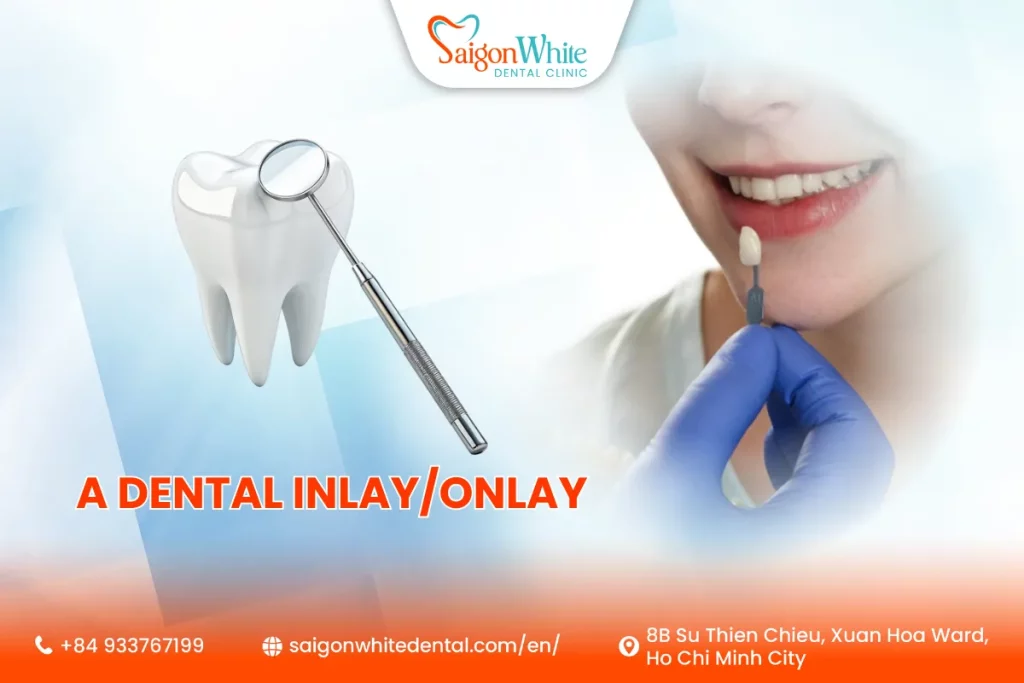When it comes to restoring damaged teeth, most patients are familiar with fillings and crowns. But what if your tooth damage falls somewhere in between—a cavity that’s too large for a simple filling but not severe enough to require a full crown? This is where dental inlays and onlays come in.
Known as indirect fillings, inlays, and onlays provide a durable, aesthetic, and conservative solution for repairing teeth. For many patients, they are the ideal middle ground, offering more strength than traditional fillings while preserving more natural tooth structure than crowns.

In this guide, we’ll explain everything you need to know about inlays and onlays—their purpose, benefits, procedure, costs, and whether they’re the right treatment for you.
What Is a Dental Inlay?
A dental inlay is a custom-made restoration that fits into the grooves of your tooth. It is often recommended when a cavity is too large for a standard filling, but does not require coverage of the tooth cusps.
Key Features of Inlays
- Placed within the biting surface of a tooth (between the cusps).
- Fabricated in a dental lab or via CAD/CAM technology.
- Made from durable materials such as porcelain, composite resin, gold, or zirconia.
- Provides a stronger and longer-lasting solution than regular fillings.
When Are Inlays Recommended?
- Moderate tooth decay that cannot be repaired with a simple filling.
- Replacement of large, old, or failing fillings.
- Patients are looking for a highly aesthetic and precise restoration.
Inlays are particularly beneficial for molars and premolars, which endure heavy chewing forces.
What Is a Dental Onlay?
An onlay is similar to an inlay but covers one or more cusps of a tooth. This is why it’s sometimes referred to as a “partial crown.”
Key Features of Onlays
- Extends over the chewing surface of the tooth, covering cusps.
- Provides added protection for teeth with extensive damage.
- Offers strength and stability similar to a full crown, while preserving more natural tooth structure.
When Are Onlays Recommended?
- Tooth damage that extends beyond the center grooves and affects the cusps.
- Cracked or weakened teeth that need reinforcement.
- Patients who grind their teeth need durable restorations.
Onlays strike a balance: stronger than fillings, less invasive than crowns.
Inlay vs Onlay vs Filling vs Crown
| Feature | Filling | Inlay | Onlay | Crown |
| Coverage | Small cavity only | Inside grooves | Grooves + cusps (partial crown) | Entire tooth |
| Tooth Preservation | Most | Moderate | Moderate to high | Least |
| Durability | 5–7 years | 10–15 years | 10–15 years | 10–15+ years |
| Aesthetics | Good (tooth-colored resin) | Excellent (porcelain, zirconia) | Excellent (porcelain, zirconia) | Excellent (porcelain, zirconia) |
| Cost | Lowest | Moderate | Higher | Highest |
👉 Summary: Inlays and onlays are the perfect option for patients who need more than a filling but don’t want their entire tooth reduced for a crown.
Materials Used for Inlays/Onlays
Porcelain
- Highly aesthetic, matches natural teeth.
- Resistant to stains.
- Popular choice for visible teeth.
Composite Resin
- Affordable and tooth-colored.
- Less durable compared to porcelain or zirconia.
- Often used for small to medium restorations.
Gold
- Historically considered the strongest material.
- Extremely durable and long-lasting.
- Less common today due to its metallic appearance.
Zirconia
- Modern material combining strength and aesthetics.
- Ideal for patients seeking both durability and a natural look.
- Suitable for both front and back teeth.
The Inlay/Onlay Procedure Step by Step
Step 1: Consultation and Diagnosis
Your dentist examines the tooth, takes X-rays, and determines whether an inlay, onlay, or other treatment is needed.
Step 2: Tooth Preparation
- Decay or old filling is removed.
- The tooth is shaped for the restoration.
Step 3: Impression or Digital Scan
- A mold or 3D scan of your tooth is taken.
- Sent to a dental lab or used with CAD/CAM to design your custom inlay/onlay.
Step 4: Temporary Filling (If Needed)
- A temporary material is placed to protect your tooth until the permanent piece is ready.
Step 5: Final Placement
- The inlay/onlay is checked for fit and color.
- Bonded to the tooth using strong dental cement.
- Adjustments are made for comfort and bite.
Timeline
- Traditional method: 2 visits, 1–2 weeks apart.
- Same-day CAD/CAM crowns: Completed in a single visit.
Benefits of Inlay/Onlay Restorations
- Preserve natural tooth: Less removal compared to crowns.
- Durability: Last longer than fillings (up to 15 years).
- Better seal: Reduces the risk of bacteria leakage.
- Aesthetics: Matches natural tooth color.
- Comfort: Provides a stable bite surface for chewing.
For many patients, inlays and onlays represent the perfect combination of function and beauty.
When Do You Need an Inlay/Onlay?
- Large cavities that can’t be treated with fillings.
- Cracked or fractured teeth.
- Teeth weakened by grinding (bruxism).
- Replacement of failing metal or resin fillings.
- Preventive restoration before requiring a crown.
Risks and Limitations
While inlays and onlays are safe and effective, patients should be aware of potential drawbacks:
- Higher cost compared to fillings.
- Tooth sensitivity may occur temporarily after bonding.
- Bonding failure if not properly maintained.
- Multiple visits required (unless same-day CAD/CAM is available).
Cost of Dental Inlays/Onlays
Average Price Range
- United States: $600 – $1,200 per tooth.
- Australia: $500 – $1,000 per tooth.
- United Kingdom: £400 – £800 per tooth.
- Vietnam (Ho Chi Minh City): $120 – $250 per tooth.
Factors That Affect Cost
- Type of material (porcelain, zirconia, gold).
- Tooth location (molars may cost more).
- Dentist’s expertise and clinic reputation.
- Technology used (CAD/CAM vs lab).
- Insurance coverage.
👉 In countries like Vietnam, inlays/onlays are much more affordable, making them a popular choice among dental tourists.
Aftercare and Maintenance
- Brush twice daily with fluoride toothpaste.
- Floss daily to prevent decay around the restoration.
- Avoid very hard foods for the first few days.
- Visit your dentist for check-ups every 6 months.
- With proper care, inlays/onlays can last 10–15 years or longer.
Frequently Asked Questions (FAQs)
Q1. Are inlays/onlays painful?
👉 No. The procedure is performed under local anesthesia. Mild sensitivity may occur afterward.
Q2. How long does the procedure take?
👉 Typically 2 visits (1–2 weeks apart) or same-day with CAD/CAM.
Q3. Do inlays/onlays look natural?
👉 Yes, porcelain and zirconia restorations blend seamlessly with natural teeth.
Q4. Can they fall out?
👉 Rarely. If bonding fails, they can be replaced or re-cemented.
Q5. Are they covered by insurance?
👉 Many dental insurance plans cover part of the cost, especially if medically necessary.
Contact Saigon White Dental Today
At Saigon White Dental Clinic, we specialize in advanced restorative treatments, including porcelain inlays and onlays designed to restore both function and aesthetics. Our internationally trained dentists, modern CAD/CAM technology, and English-speaking staff ensure that every patient—local or international—receives world-class dental care.
Address: 8B Su Thien Chieu, Xuan Hoa Ward, Ho Chi Minh City
Hotline / WhatsApp / Zalo: +84933767199
Website: saigonwhitedental.com
Email: hi@saigonwhitedental.com
👉 Book your consultation today and let us help you achieve a brighter, healthier smile with durable and natural-looking inlay/onlay restorations.

 Telegram
Telegram